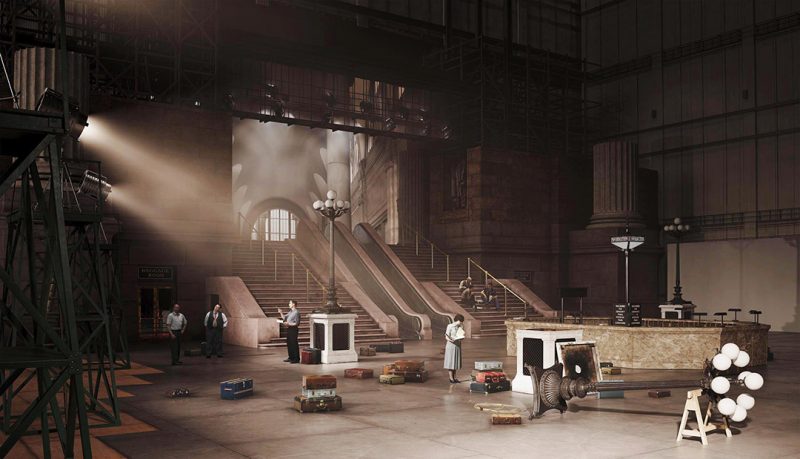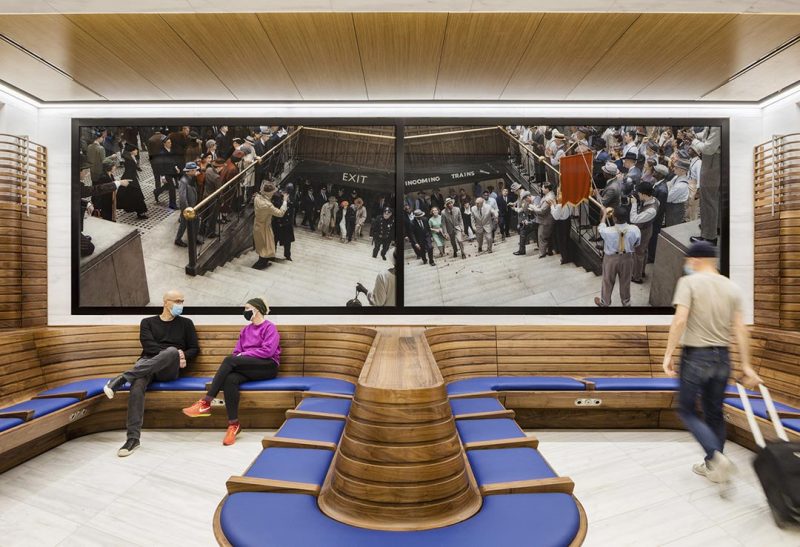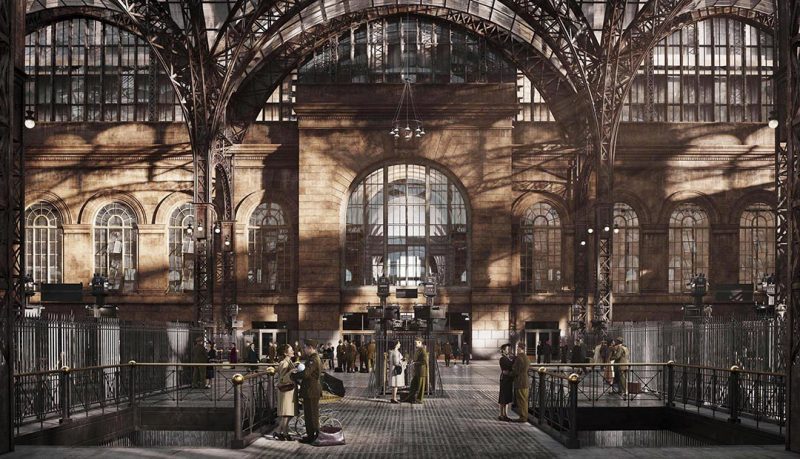[Summer 2021]
Stan Douglas, Penn Station’s Half Century
By Stefan Zebrowski-Rubin
Moynihan Train Hall, New York City
Beams of light shine across an abandoned hall stacked with suitcases. Groups of men assemble at various points as a woman, clipboard in hand, takes inventory by the marble-cladded information desk. In the foreground, a Victorian-style lamppost lies on its side. Looking beyond the central scene, one sees that the floor ends abruptly; the wall and column are only half built – we’re on a soundstage in Hollywood in September 1944.
The final vignette in a nine-panel work by Canadian photographer (and 2016 Hasselblad Award winner) Stan Douglas set in New York’s Penn Station, the photograph described above replicates the L.A. set of The Clock, which could not be filmed on location due to the Second World War. These layers of fact and fiction perfectly exemplify Douglas’s work and its sweeping ambition. Penn Station’s Half Century (2020), installed alongside a ceiling sculpture by Elmgreen & Dragset and a stained-glass work by Kehinde Wiley, make up the commission organized by the Public Art Fund and Empire State Development for the Moynihan Train Hall in New York City and unveiled in January 2021. The skill and ambition shown in these breath-taking tableaux inspire curiosity and expectation for Douglas’s representation of Canada at 2022 Venice Biennale.
Because the pandemic, Douglas wasn’t able to leave his native Vancouver during the creation of his work. Even had he been able to travel to New York, however, he could not have shot in the original Penn Station; the large Beaux-Arts style building, completed in 1910, was demolished in 1963 to make room for construction of Madison Square Garden, and its disappearance provided the catalyst for the modern historic preservation movement. Through historical research, computer-generated reconstruction, and a carefully planned photo shoot, Douglas created a project that mines architectural and historic nostalgia while commemorating what he calls “transitional moments” to poignant effect.
Within the four niches of the final installation, Douglas has composed panels documenting fantastical re-creations of moments in his selected history from 1914 to 1957. In the spirit of the paintings of Brueghel the Elder (whom Douglas notes as a reference), Douglas’s vignettes display a multiplicity of stories and discovered histories. In the first two panels, vaudeville performers, snowbound in 1914, put on performances organized by Bert Williams, known as the first African American to direct a motion picture. The next two panels, from 1924 and 1934, feature crowds welcoming convicted thief Celia Cooney (aka the Bobbed Hair Bandit) and Angelo Herndon, a Black labour organizer freed by public support. The third niche, with three panels, shows the evolution of the ticket hall from 1930 to 1957: a Ford Tri-Motor plane standing in the concourse, immense portraits celebrating railroad employee war heroes, and the installation of electronic ticketing under a swooping aerodynamic lit canopy. The final niche, paired with the aforementioned film set, foregrounds the tearful goodbyes to wartime servicemen in 1941. Although based on extensive research and selected from among thousands of articles depicting real figures and events, the scenes themselves – titled with specific dates – are a fantasy, composed of multiple shots stitched together within a computer-generated reconstruction of the station.
Working in the carefully gridded, five-thousand-seat Agrodome Arena in Vancouver, the four-day photo shoot with over four hundred actors and five hundred costumes (from Montreal and Los Angeles) took place with precise planning and COVID-19 safety protocols. Douglas and his team worked on a cinematic scale, matching virtual and optical space, mindful of proportion and composition, employing cranes and powerful light arrays. The composed conceptual work of the Vancouver School of photography here takes on epic new ambition and blurs lines between media.
This commission allowed Douglas to make use of his previous experimentation with ceramic ink on glass, with the printing contracted out to a New Jersey company. With each niche measuring approximately 2 by 6.7 metres and divided into two or three panels, the resulting images are massive and immersive. The deliberate compositions startle the viewer in their hyperreal detail – the resulting works are akin to history paintings, though the “epic” is found in small moments alongside the transitions . . . the wane of train travel and the rise of on-screen entertainment.
No stranger to the world stage, as he has been featured multiple times in documenta and at the Venice Biennale, Douglas has risen to the occasion for his first permanent public commission in the United States, making the lead-up to Venice 2022 all the more exciting in the wake of a transition into a post-COVID era. Doubtless, Douglas will continue to push the boundaries of his chosen medium and challenge the viewer.
Stefan Zebrowski-Rubin is a Montreal-born London-based art world professional. He worked with Hauser & Wirth for eight years after obtaining his MA from The Courtauld Institute and his BA from Harvard University. He currently works as a freelance writer and editor, writing weekly cultural reviews for the Canada-UK Foundation, collaborating with Hauser & Wirth on a Frank Bowling catalogue, and reorganizing the library for the Zabludowicz Collection.
[ See the magazine for the complete article and more images : Ciel variable 117 – SHIFTED ]



